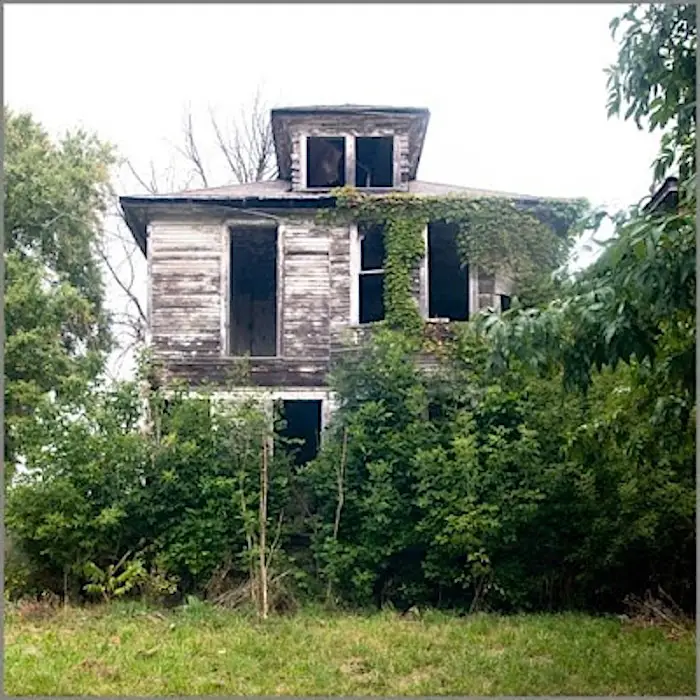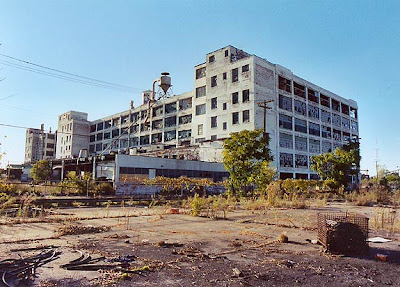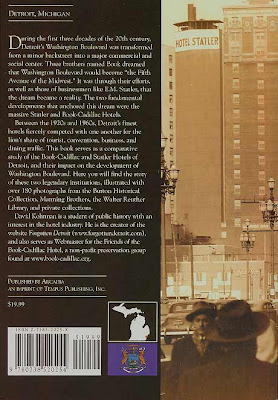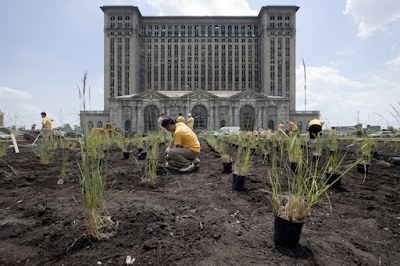
Anyone who has visited Detroit, Michigan in the past quarter century can’t help but be saddened by its increasingly dilapidated state. That same bleak, rundown quality of a once thriving city of industry, however, serves as inspiration for various painters, writers and photographers.
The Demise Of Detroit in Photographs and Art
Classic theaters, demolished landmark buildings, now empty factories of automotive companies, abandoned schools, rundown homes and once lively neighborhoods – especially Brush Park– are captured and immortalized by many, including these six photographers and one painter.

Whether the artists were born and raised in Michigan or relocated to the area (two of the photographers are actually French), they were moved enough by the present state of the city to document it in their oevre. Clearly, the wistful ruins of the city serve as a muse for these following talents.
You may notice that a few of the landmark buildings and abandoned houses have been shot by more than one of these photographers, so what may seem like duplicates are just the same subject as captured by different people.
David Kohrman

First off, photographer David Kohrman, a Western Michigan University grad, drawn to the ruins of Detroit, created a site in 2001 named Forgotten Detroit. A self-proclaimed lover of history and architecture, he had taken an interest in the historic preservation of landmark buildings.
In his own words:
“This site is a presentation of the historical and present day information I have compiled on some of these buildings. I have spent a great deal of time digging up facts and photos of these places. In 1999 I was fortunate enough to tour many of the major ruins. My intent with the site is to preserve the memory, and hopefully shape opinions in favor of the preservation of these landmarks.”
The site (which has not been kept up, much like Detroit) features intensive sections of various demolished and existing architecture including historical and present day photos of hotels, theaters and more.
However, David has continued to pursue architectural photography and he now has his own site which features more beautiful architectural photography here.
Some examples of images from David Kohrman:




The Fisher Body 21 Building:



The Madison Theater:

and as it once stood:

Having moved to Indiana for Graduate school in 2005, David Kohrman has not been able to return to Detroit as frequently and therefore the site has not been updated since then. David has had a few books published on this very subject.


above: A companion to the Forgotten Detroit website “Detroit’s Statler and Book-Cadillac Hotels” is a look back at the glory years of Detroit’s two leading hotels. 183 photographs divided into 4 chapters cover a wide range of topics such as construction photos, people, events, interior, exterior, and eventual decline.
Buy the book here.
•Visit Forgotten Detroit here.
Be sure to visit David’s more recent site and photography here.
David Schalliol

David Schalliol opens the text on his site with a quote about Detroit by US President Harry Truman:
“I do not suppose that Cadillac and his little band of pioneers would believe their eyes if they could see what has happened on the spot where they built this fort back in 1701.” — United States President Harry S. Truman at the celebration of Detroit’s 250th anniversary, July 28, 1951
Schalliol captures, not just the buildings, but the occupants of the city and neighboring suburbs. Here are a few of his beautiful photographs from his series of Detroit:









Selected prints from David Schalliol’s Detroit series are available directly from the photographer.
James D. Griffioen
James D. Griffioen has several series of photos that document the sorry state of Detroit; feral houses, be patient, lost neighborhoods, little houses and scrappers. Below are a few of his images from those series.
Feral Houses:


Lost Neighborhoods:



Abandoned schools:


He also has documentary series and polaroids that capture Detroit.
There’s lots more to see of his work here.
Kevin Bauman

Photographer Kevin Bauman‘s 100 abandoned houses is just one example of his series of Detroit photos (there are actually 104 to see).
Below are some examples of his work:




He also has other photo series of Detroit. Some in black and white, some specifically of Brush Park and various other areas and buildings of the city, like the old Fisher Body plant shown below.

You can see those all here.
Yves Marchand and Romain Meffre

French photographers Yves Marchand and Romain Meffre documented Detroit’s demise in a photo essay titled Detroit’s Beautiful, Horrible Decline for Time Magazine.
Here are the images from that photo essay:







Their stunning series, The Ruins of Detroit, will be published by Steidl as a book with 150 color images this year, due out in May 2010. You can pre-order the book here.
Stephen Magsig
Also worth noting are the wonderful paintings of Stephen Magsig, about whose work I have written before.
Painter Stephen Magsig has a beautiful series of small paintings capturing abandoned buildings, rundown homes and lonely street corners. Most of his “Postcards from Detroit” series have been sold, but luckily for you, the prolific fine artist continues to add to the series daily with his paintings on Daily Painters.








Postcards From Detroit, Volume I
Postcards from Detroit, Volume II
There are many blogs, sites and movements to save the Motor City. Detroit is trying to rebuild, save landmarks and once again become a thriving metropolis.
The Detroit Institute Of The Arts is presently running a Let’s Save Michigan poster design contest.

The Detroit Declaration is an organizing document for people who love Detroit, who sense that there is a growing tide of consensus about what the city must do differently to thrive, and who are willing to invest time and energy into the political process to see that consensus emerge on a transformative scale.